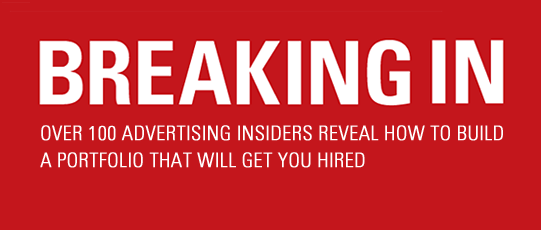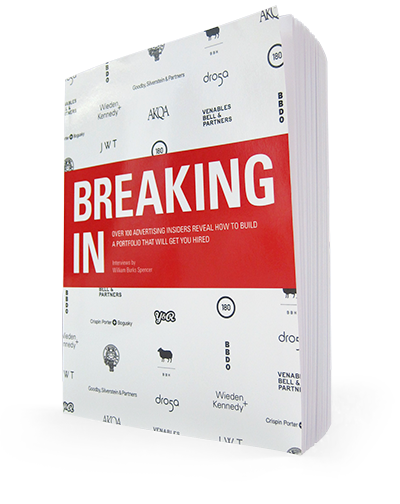If you missed yesterday’s post, take a look at some of Ji Lee’s work.
WS: What do you look for in a student book? And what impresses you?
JL: I receive lots of emails with students’ portfolios. From both students
and recruiters. So, for me, the first thing I look at in a portfolio is how a
student organizes his or her work. Good navigation and ease of use are
very important. No matter how great their work is, if I am lost in their
website, if I have to take a few extra seconds to find something, then the
person already lost me. This is also an indication of how well the person
knows how to communicate his or her message. So, if I’m lost in the
navigation, that tells me this person doesn’t know how to use the web to
communicate his own message. Lots of people these days use Cargo or
Index Exhibit and they work well.
WS: Can you explain “Cargo” and “Index Exhibit”?
JL: They are portfolio website templates. They’re probably the most
widely used templates for designers and people in advertising. The great
thing about them is that people can customize the way they want their
sites to look and they don’t have to know PHP or coding. It’s a really easy
way of showing your work.
WS: Okay.
JL: And then, once I am navigating the website easily, obviously I’ll be
looking for the quality of the work. And the work has to be well presented.
Is it well photographed? Is it well designed? Is it well written? Is it concise
and does it communicate the idea quickly? So there are a few steps even
before the work; packaging an idea is as important, if not even more
important, than the idea itself.
And while I’m looking at the work, I’m looking for the kind of work that is
non-formulaic. I see lots of students’ portfolios that are formulaic. Many
students, for instance, do environmental work, like doing things on the
escalator or revolving doors or on the sidewalk and appropriating objects
and transforming them into some kind of brand message, which I think
is fun but that’s what everybody does. So I think it’s fine to have a few
environmental installation pieces but if the book is filled with those things
then it feels that the person is not really exploring something beyond.
Same thing with the print ad: some kind of an intriguing image in the
center and then a tiny logo at the bottom-right. That’s the formula that
I’ve been seeing over and over again over the years. So I’m not really
interested in those kinds of formulas, I’m interested in big thinking.
I’m interested in “idea people” who are really thinking about media. So
there’s a problem and there’s a solution. How do you spread that solution
creatively throughout different media? Do you know how social networking
works and how you create a gadget that lives in Facebook and how you
would really spread that idea?
WS: And what do you think about print ads? Is that still important
because it’s a way to judge someone that’s very standard among different
books, rather than if someone just comes in with all new media?
JL: Well, I think what a lot of people are looking for these days is
360-degree thinking. So I’m looking for someone who is not bound by
medium but bound by the idea, and media is there to support that idea. If
print is what works for solving that particular problem, that is good. But
if the person is doing print because that’s just the way things are done,
then I think the person is still in the old school of thinking. So maybe
the solution for that particular product or brand is creating a chair or
creating an in-flight magazine or creating an event in Times Square,
and maybe the print ad is not appropriate for that particular product. So
I don’t think that print is an absolutely necessary thing to have in your
book.I think ten years ago, because media was limited, you did print, you did
TV and radio and outdoor. But nowadays, it’s really wide open. There’s
gadgets, there are social networking aspects, rich media ads, and
there is print and there is outdoor. But I think when we’re creating these
messages, we’re creating it mindful that a consumer will experience this
in many different layers of their lives. So when they wake up, they may
listen to the radio ad, and then on the way to work, they may receive a
three-word message about this new particular initiative of a brand, and
then when they go to work, they may turn on the computer and they may
find a Facebook post from another friend, and so on and on. So you know,
it’s a wide range of sensorial and media blips that we get. And so the
person would have to really think about the whole thing. And the more
360-degree thinking that’s in the book, the better.
WS: And how have you seen people present these things, either good or
bad? Because when you do a 360-degree campaign, it can be so many
different things that it can be overwhelming for someone to look through
and get the idea.
JL: True. Well, I think it has to be self-explanatory, with very little text,
living in your website. So the person never needs to be sitting next to me
saying, “This is how I did it.” I think what lots of students end up doing is
that they are so used to presenting the work to their teacher in college,
they automatically assume that is the format. And that is not true. You
know, most of the time you’re just sending the link in and you have to
let the viewer figure it out on their own in a really easy way. I teach at
SVA [School of Visual Arts] and that’s one thing that I stress the most.
Obviously, the packaging and then how do you explain this idea visually
so that it stands on its own? And if there is a complex project, then I
think I would first introduce the brand or the product, and then set up
the problem or the challenge, and then the solution. So, in one or two
slides, you learn about this product, you learn about the challenge, and
maybe you have to write that in very small, short sentences, and then you
learn about the solution. And then you go on: “In this solution, there is an
outdoor element, there is a print element, there’s a TV spot,” and so on.
WS: You mentioned that the presentation is very important in terms of
clarity and that it looks good. Is the craft also important? For an art
director, do you want to see evidence of amazing design, and for writers,
do you want to see copy?
JL: Absolutely. And I think this idea of writer versus or director versus
designer is becoming blurry and blurrier. So I expect any presentation
to have all that stuff and still look beautiful. It doesn’t matter if it comes
from a copywriter or art director. If it comes from a copywriter who
cannot design, then I think it’s the copywriter’s job to find the right
designer or a partner to make that look beautiful. Because we end up
doing lots of presentations internally and presentation is, again, as
important as the work itself. So we’re looking for someone who can
generate ideas and also present that idea in a really beautiful, simple
way. So presentation, design skills, all that stuff is really important.
WS: What do you think about including stuff in a book that is not
advertising? Things like personal projects and art or photography or
journal writing or things like that?
JL: I think for me, personally, it’s a huge plus. My personal vision is that
personal projects are extremely important both for personal growth and
also end up helping you professionally. I’ve done lots of personal projects
like “The Bubble Project” or “3D Alphabets” or the “World Trade Center
Logo Preservation Project” or “Goollery”…these are personal projects.
And because of those personal projects, I was able to find good jobs in
good places. You know, it’s not because of my ad/design portfolio. If I only
did professional projects, I wouldn’t be in such a place that I would like to
work for. So I definitely look for personal projects and I encourage young
designers and art directors and copywriters to include their personal
projects. Because that’s where the real personality comes out and the
passion and quirkiness, and that’s where you can really see what kind of
interests this person has. I’ve seen so many books with Doritos ads or
some bowling-alley ads or condom ads. Those could be fun but I think the
level of interest is very low. But then, if you found a personal project that
comes from their own voice and their own passion, it’s always unique and
it’s always interesting.
WS: Do you have any more advice for someone who is just starting out?
JL: The other advice that I have is to make it as personal as possible.
So you can enclose your photograph, or tell your stories about where you
come from, or if you have a rich ethnic background or special interests
or if you’re a climber or you’re a collector of something, that is a plus. All
those little quirks make me feel connected to that person because I have
learned a little more about them.And being open so that you can share…maybe creating platforms, open
projects where you invite other people to participate in making things.
Those little details I think makes me get a sense that, “Okay, this person
gets the web.” And by making a lot of the contents creative commons.
The fact that he put, “So and so, 2010 copyright,” makes me realize the person is still thinking old media. But the person who puts “CC,” creative
commons, makes me think, “Okay, this person understands open source”
and the power of spreading ideas and all that. So that may be a very
small detail but those things matter.And there are other small things: Coming up with the URL of your
website. If you have a long, complicated name with lots of consonants,
then I would encourage you to think about another name. Like, in
my case, ”jilee.com“ was already taken and so I had to think about
another name and I came up with “pleaseenjoy.com.” So when I talk
about “pleaseenjoy.com“ in a cocktail party, people are probably more
likely to remember that than Ji Lee. You’re building your own brand, so
I’d treat your website and your business card, the way you dress, the
way you present yourself, everything as if you’re building a brand in a
professional context. Would you like to be known as John Doe or would
you like to be known as a unique brand name? There’s no good or bad,
but it’s something that you should be thinking about.


Comments are closed.